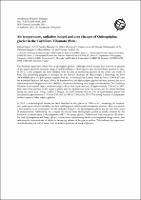Air temperature, radiation budget and area changes of Quisoquipina glacier in the Cordillera Vilcanota (Peru)
Metadata
Show full item recordAuthor(s)
Date
2015Collections
- Congreso [32]
Related Resource(s)
https://ui.adsabs.harvard.edu/abs/2015EGUGA..17.5639S/abstractAbstract
The Peruvian Andes host about 71% of all tropical glaciers. Although several studies have focused on glaciers of the largest glaciered mountain range (Cordillera Blanca), other regions have received little attention to date. In 2011, a new program has been initiated with the aim of monitoring glaciers in the centre and south of Peru. The monitoring program is managed by the Servicio Nacional de Meteorología e Hidrología del Perú (SENAMHI) and it is a joint project together with the Universidad San Antonio Abad de Cusco (UNSAAC) and the Autoridad Nacional del Agua (ANA). In Southern Peru, the Quisoquipina glacier has been selected due to its representativeness for glaciers in the Cordillera Vilcanota considering area, length and orientation. The Cordillera Vilcanota is the second largest mountain range in Peru with a glaciated area of approximately 279 km2 in 2009. Melt water from glaciers in this region is partly used for hydropower in the dry season and for animal breeding during the entire year. Using Landsat 5 images, we could estimate that the area of Quisoquipina glacier has decreased by approximately 11% from 3.66 km2 in 1990 to 3.26 km2 in 2010. This strong decrease is comparable to observations of other tropical glaciers.
The following license files are associated with this item:








